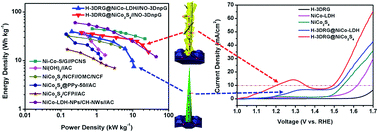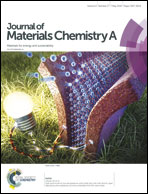Designed synthesis of NiCo-LDH and derived sulfide on heteroatom-doped edge-enriched 3D rivet graphene films for high-performance asymmetric supercapacitor and efficient OER†
Abstract
Nowadays, robustly coupling electroactive inorganics with bicontinuous graphene-based films is highly desirable for high-performance energy storage devices and electrocatalysts. Herein, free-standing heteroatom-doped edge-enriched 3D rivet graphene (H-3DRG) film with high flexibility and conductivity was obtained as a substrate to deposit vertically arranged NiCo-layered double hydroxide (NiCo-LDH) nanoneedles via a hydrothermal approach and hierarchical NiCo2S4 nanostructures by further in situ anion exchange process without destroying the original vertical architecture. The carbon nanoparticles located on the surface of bicontinuous 3D porous graphene show gradient and edge-enriched structure, which can provide much more nucleation sites and better attachment of electroactive inorganics than traditional 3D porous graphene films with interconnected carbon layers prepared by the chemical vapor deposition process. Such outstanding structural advantages accelerate the reaction kinetics and enhance electrochemical activities which mean that H-3DRG@NiCo-LDH- and H-3DRG@NiCo2S4-based asymmetric supercapacitor devices both show high energy densities of 39.4 W h kg−1 and 37.6 W h kg−1 based on the entire devices, respectively. Furthermore, these hybrids also favor the oxygen evolution reaction process, which deliver a mass oxygen production current density of 10 mA cm−2 at low overpotentials of 289 and 264 mV in 1 M KOH, respectively.



 Please wait while we load your content...
Please wait while we load your content...